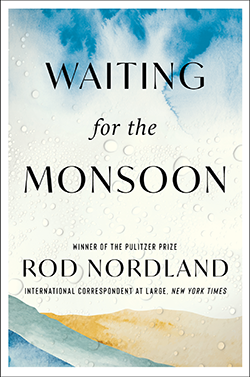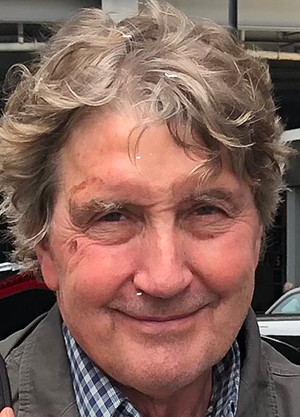
Excerpted from the book WAITING FOR THE MONSOON by Rod Nordland. Copyright © 2024 by Rod Nordland. From Mariner Books, an imprint of HarperCollins Publishers. Reprinted by permission.
Rod Nordland, a former international reporter for The New York Times, was working in India when a sudden seizure led to a diagnosis of glioblastoma multiforme. He underwent surgery with Dr. Philip E. Stieg shortly thereafter. A five-year survivor of this malignant brain tumor, Nordland has published a book (Waiting for the Monsoon) about the experience. An excerpt is below, along with an episode of Dr. Stieg's podcast in which Nordland talks candidly about the experience.
After I was struck down by my first, and worst, seizure on the street in New Delhi on July 5, 2019, the first person to arrive by my hospital bedside was Leila, who could still travel with the tourist visa she had gotten for our very recent, and now unthinkably remote, holiday there. We had not included a hospital on our list of destinations, but it briefly became the center of our universe. We had only recently moved in together in London. On July 6, the very day after my seizure, Leila arrived and took charge of my treatment, keeping my employers, my family, and my friends informed of what was going on. Leila also had to help the nurses subdue me because I was trying, rather violently apparently, to climb out of my hospital bed. In the end they had to use leather-and-Velcro restraints, which I later realized were the source of bruises on my wrists and ankles, forearms and legs.
Naturally, I remember none of this but heard all about it later from Leila, who witnessed it while frantically calling friends, family, and colleagues, asking for help. At six feet in height, she’s bigger than me but nowhere near as strong. The Times immediately hired a private male nurse to help her.
Once it is diagnosed, glioblastoma is considered a stage 4 cancer — meaning it is incurable. I titled my next journal “The Middle Finger of God,” after I realized that I was afflicted with a disease with no known environmental or lifestyle causal factors. Even heavy smoking isn’t associated with a greater risk of getting it — as it is with almost every other form of cancer. For me and for others, this invader of the brain can be attributed to only the cruel, capricious vagary of chance. Why on earth did I bother to eat all that kale? (A tombstone in a New Yorker cartoon put it that way.)
So, you get a dire diagnosis, and even if you are not a journalist, you start doing the research. But if you are a journalist, the intensity of that research is supercharged — you go deep, audaciously interviewing folks who might know more so you can get to the bottom of the story. I badgered my doctor friends for access to medical websites, which meant “find the best treatment, get the best doctors, cure the uncurable.” And naturally, everyone you know — family, friends, fellow reporters — is doing the same thing. You start simply by googling “glioblastoma multiforme” and are assaulted by words like “incurable,” “highly aggressive,” “poor prognosis,” “always fatal.” You find the Glioblastoma Foundation. You see that the organization is “Transforming Glioblastoma Therapy.” (And you wonder why it needs to be transformed.) And the answer appears: the foundation complains and lobbies for action to address the fact that the standard of care hasn’t changed in forty years, nor have survival rates. “Glioblastoma is an aggressive and devastating cancer, with a median life expectancy for patients of 15 months post diagnosis. The long-term prognosis for glioblastoma remains poor. The current standard of care consisting of surgery, chemotherapy with Temodar, and radiation, is not very effective.”

Rod Nordland; photo by Matthew Naython
"The photo was taken just as I arrived at Weill Cornell Medicine after a 50-hour-long medevac from India, looking somewhat the worse for wear and a bit battered by seizures."
You discover that you are one of the approximately fifteen thousand Americans who are diagnosed with this wretched disease every year. And you also discover that men are 50 percent more likely than women to be diagnosed with glioblastoma. Well-educated white men get this cancer more than any other demographic, and the median age for those of us who are conscripted to fight in this war is sixty-five. You keep searching and find another brain tumor site that tells you that the five-year survival rate for glioblastoma patients is 7.2 percent. (It appears that things have marginally improved since my diagnosis, thus making my “6%” T-shirt obsolete.)
And then you start looking for the boldface names, the GBM-4 poster guys — now all dead — to see what they went through. John McCain was eighty and running for president when he was diagnosed; Ted Kennedy was seventy-six. Each lived only a year. Beau Biden was forty-one when his headaches, numbness, and paralysis landed him in the hospital — but he was diagnosed as having had a mild stroke. Then, in 2013, he joined our exclusive club, and two years later he was dead at forty-six. I got my news around my seventieth birthday. I cannot begin to figure out what this means in terms of the actuarial tables, but in terms of my life, there were already more yesterdays than tomorrows when glioblastoma reared its ugly head in July 2019, which was nearly three and a half years ago as I write this.
At first, it seemed as if the seizures, not to mention the tumor’s assault on my brain, had come out of nowhere — in an instant. But when my memory rallied, I recalled that, for almost a year, I had been getting aberrant headaches every morning, very much like hangovers even though I wasn’t drinking, and I am someone who very rarely suffers headaches. I blamed them on the statins I was taking due to high cholesterol. I had also experienced a somewhat weird rush of creative energy during this time, which was equally out of character. I am a hard-nosed, fact-based foreign correspondent with more than forty years’ experience in war zones — a nonfiction guy through and through. But for unexplained reasons, and not only because of Leila’s influence, I had begun writing poetry. I also took up — of all things — origami. Odder still, I even began making hand soaps. These new hobbies were pleasing and enjoyable, a yin to my life’s yang, but where did they come from? They were at odds with my self-image as the rough-and-tumble war correspondent, the tough bureau chief managing staffs of dozens, in places like Kabul and Baghdad, Sarajevo and Kosovo, Skopje and Tirana. Stranger, perhaps, were the changes in my dispatches. They were more descriptive, more emotional; they had more brio. They were, in short, more “creative,” if we understand the term to refer to that mysterious and liberating force behind works of imagination.
Could I point to all this as early evidence of a tumor beginning its incursion into my right parietal lobe — a region that manages the integration of one’s five senses into language and cognition? And the place where, some scientists believe, creativity originates? Or is the answer as simple as this: I was in love with a poet. (Though that does not explain my headaches.) It is impossible for me to say.
See also: Recovering from a GBM, which Rod Nordland shared with us a year after his surgery, and One of the Lucky Few, Dr. Stieg's blog post about GBM prognosis.
For more about the book, visit the HarperCollins web site.
Hear Rod Nordland on Dr. Stieg's podcast, This Is Your Brain